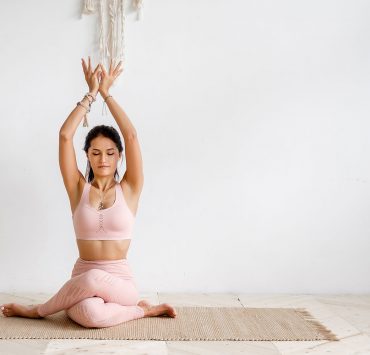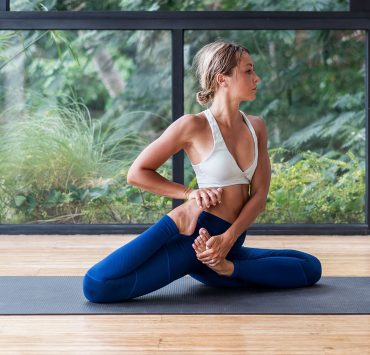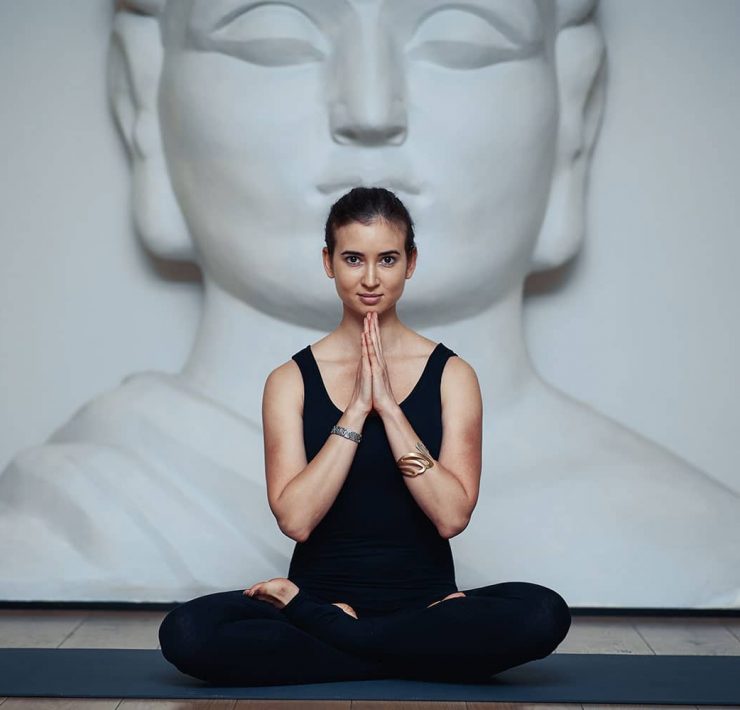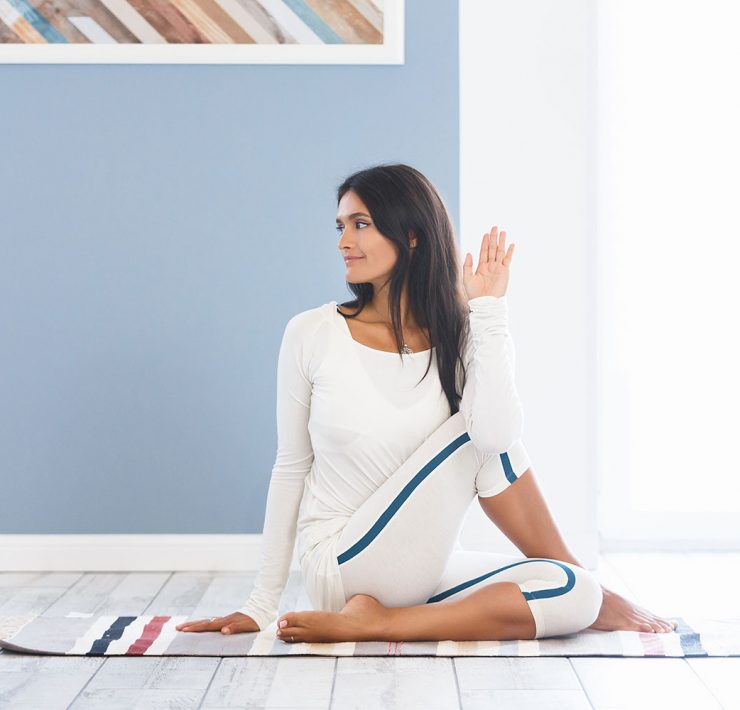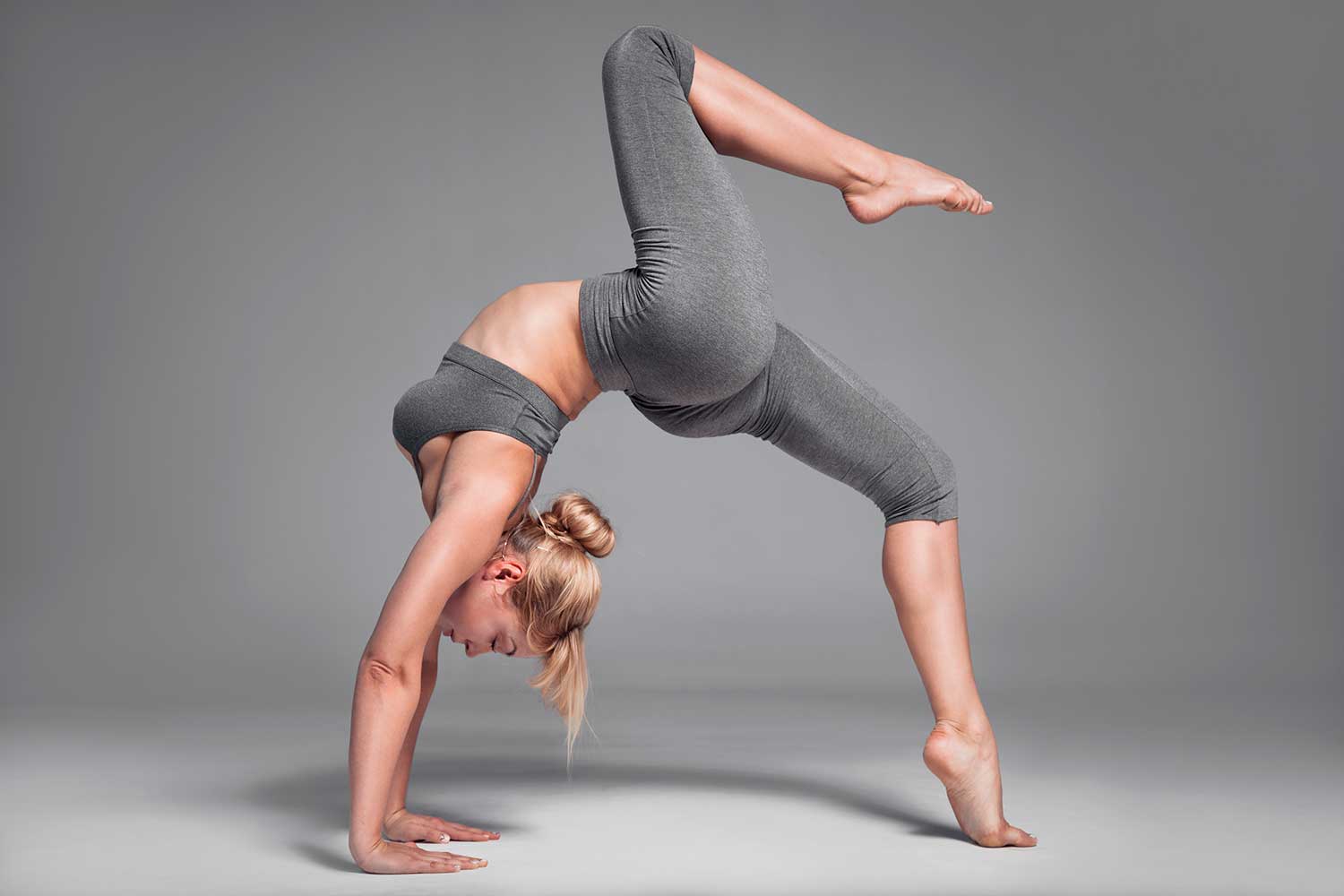
After spending nearly two decades as a relationship therapist, Patricia…
Every yoga pose brings with it a unique blend of benefits, but there’s a few fundamental shapes that stand out above the rest. Not only are you more likely to encounter them in a yoga class, but they’re important stepping stones towards more advanced postures. Knowing these poses beforehand will also make you feel a little less lost the next time you’re in a class. So, if you only ever learn 30 yoga poses, the ones listed below are really all you need to know.
Adho Mukha Svanasana — Downward Facing Dog Pose

Arguably the most well-known yoga pose of them all; Downward Facing Dog brings a perfect balance of strength and flexibility. Most yoga classes feature this classic posture at least a few times, so it’s wise to familiarize yourself with the proper alignment beforehand. Start on all fours with wrists slightly forward from the shoulders and hands at shoulder-width. Tuck the toes under and lift the hips while working the legs towards straight. Add a soft bend to the knees as you root down through your base and draw everything toward the midline. Focus on allowing the heart to melt down while the tailbone tips up, and the neck relaxes.
Chaturanga Dandasana — Four Limbed Staff Pose

Also known as Chaturanga Dandasana, this low controlled plank really turns up the heat. It’s easy to cheat during this pose, but that won’t do you any good in the long run. From a regular plank pose with wrists under shoulders and fingers spread wide, slowly lower half way down. Draw the elbows close to your sides as you activate through the legs and core. Avoid sticking your bum up in the air or collapsing in the lower back.
Savasana — Corpse Pose

It may not look like it, but many refer to Corpse Pose, or Savasana, as the most challenging yoga posture. It requires more mental strength and control than it does physical exertion; the trick here is to stay fully relaxed through the body. Lay down and let your full body surrender into the mat, employing props to deepen the experience as necessary. Instead of fixating on clearing the mind of thoughts, simply notice where it goes without getting attached.
Bhujangasana — Cobra Pose

Channel your inner serpent and prepare for deeper postures with this gentle, fluid backbend. If you’re feeling restricted in backward movement or tight across the chest, this is the perfect place to start. Lay on your belly with tops of the feet rooted down and palms under the shoulders. Keep the elbows close and the pelvis grounded as you inhale to lift the chest from the mat. Reach tall through the crown of the head, draw the shoulders down and back, and expand across the collar bones.
Salamba Balanasana — Child’s Pose

Ah, sweet relief! It’s the pose that’s always there when we need it most. It’s important to be familiar with Child’s Pose, that way you’ll know where to go if you need to cool down and catch your breath. From a kneeling position, bring the big toes and knees together as you start to walk the hands forward. If you’re feeling flexible in the hips, let the knees go wide as you melt the heart down. Bring your third eye center to rest on either the mat or a block and breath with the whole back body.
BADDHA KONASANA – Cobbler’s Pose

Let gravity do the work in releasing your inner thighs and groin in this classic feel-good pose. Sitting tall, bring the soles of the feet together and draw the heels in as close to the sit bones as it feels comfortable. Support yourself in this shape by bringing blocks under the hips or knees. Notice where you’re holding tension and use the breath to release it from the body.
Supta Matsyendrasana — Supine Twist Pose

Twists are an excellent way to wring out the body, nourish the organs, and remove toxins. In a supine twist, the body can fully restore in a therapeutic environment with very minimal effort. To enter this passive stretch, lie on your back and draw one or both knees towards the chest. On an exhale, drop the knees to one side and allow the gaze to track in the opposite direction.
Ardha Matsyendrasana — Half Lord of the Fishes Pose

If you’re looking for a more active twist to incorporate in your practice, this seated alternative is the way to go. It’s easy to modify and allows the spine to release from bottom to top. From a seated position, cross your left leg over the right and plant the left foot down. Depending on what feels more natural, you can bend or straighten the right leg to support length in the spine. On an exhale, twist towards the left; starting from the base of the spine and working up to the gaze.
Tadasana — Mountain Pose

As the name implies, this pose embodies strength and stability, even if it doesn’t appear terribly impressive at first glance. Mountain Pose, or Tadasana, is a staple posture in most classes and the foundation upon which most standing poses are achieved. As you stand tall with big toes together and heels slightly apart, let the shoulders soften away from the ears while the spine grows long. Engage the legs by pulling the kneecaps up the thighs and tighten through the core.
Setu Bandha Sarvangasana — Bridge Pose

Many beginners in the yoga world recognize Bridge Pose as it often appears in workout routines. However, if the alignment gets overlooked in this backbend, strain and injury become a real risk. Lie down flat on your back with knees bent and feet at hip-width. Plant both palms by your sides and start to root through the heels to lift the hips skyward on an inhale. Shimmy the shoulders under to interlace the fingers or use the hands to support the lower back. As you breathe here, keep some space between the chin and chest to maintain length in the neck. If this feels like too much to start, try using a block under the sacrum.
Anjaneyasana — Crescent Pose

Another familiar pose that stretches and strengthens the legs is Crescent Lunge. Find your way into this challenging shape by starting in Mountain Pose and stepping your right foot back into a wide stance. Bend deep into the left knee and make sure to keep it stacked directly over the ankle. Stay high on the ball of the right foot as you engage the entire backside of the leg. Bring both arms up by your ears and settle down with the pelvis to relish in the power of your lower body.
Utthita Parsvakonasana — Extended Side Angle Pose

In addition to being a wonderful strengthening posture, Extended Side Angle Pose opens the inner thighs and brings a great stretch across the shoulders. Step your left foot back in a wide stance and adjust the feet, so the front heel is in line with the back arch. Bend deep into the right leg, stacking knee over heel, as you bring the right hand down to the inside of the right foot. Use a block here if that feels more accessible, or bring the forearm to the thigh. Reach the left arm overhead and find the line of energy from the fingertips out through the back foot.
Virabhadrasana II — Warrior II Pose

The warrior postures are common in many yoga classes as they encourage students to realize their strength while increasing flexibility. Warrior II opens the inner hips while emphasizing proper alignment in both the upper and lower body. From a standing position, step your left foot back to take a wide stance. Point the right toes forward and turn the left foot flat, allowing the front heel to align with the back arch. Extend the arms out wide in a T-shape so the hips and shoulders both open to the side. Bend deeply into the front leg, stacking the knee over the ankle and pressing the thigh out.
Trikonasana — Triangle Pose

Contrary to the name, Triangle Pose is about more than achieving perfect geometry. You should feel the creation of space in the spine and legs as well as a slight burn in the abs. Starting in a high lunge with the left foot forward, turn the back foot flat and begin to straighten the left leg. Bring your left hand down to rest on either the s hin or a block as you reach the right hand straight up. Engage through the core and broaden across the chest as you breathe here.
Marjaryasana — Cat/Cow Pose

Spinal waves are a fantastic introduction to any yoga practice and a great remedy for backaches, which is likely why they’re so often featured. Start on all fours with wrists stacked under shoulders and knees under hips. Spread your fingers wide and root down in the space between the thumb and index. Inhale to drop the belly down while the gaze and tailbone lift. On your exhale, round the spine while tucking the tailbone and chin. Flow through this movement, staying connected to the breath, for three to five rounds.
Uttanasana — Standing Forward Fold Pose

Forward folds are more than just an excellent way to ease back pain; they enable us to witness a change in the body as flexibility increases. With the feet at hip-width, let the upper body drape freely over the legs, keeping them as bent as it feels appropriate. The greater the bend in the legs, the deeper the release in the lower back. Either let the arms go heavy to the floor, or grab opposite elbows and allow yourself to surrender to gravity. Allow the spine to decompress and the body to grow heavy by using your exhales as a tool for a more profound release.
Virabhadrasana I — Warrior I Pose

Warrior I is the perfect pose for anyone who spends a fair amount of time seated. It releases tightness in the hips and lower back while stretching the hamstrings and glutes. Start standing and step the left foot back, turning the back foot out at a 45-degree angle. Squeeze the thighs as you raise both arms by the ears and engage the core. Draw your right hip back and settle the pelvis down and forward. Actively press through the left foot to energize the back leg as the upper body lifts.
Phalakasana — Plank Pose

Plank Pose is more than just a form of workout torture; it cultivates stability and mental focus while bringing on the burn. From a tabletop position with wrists stacked under shoulders and fingers spread wide, lift the knees and send both legs straight back. Firmly root down through the hands to open the upper back and avoid letting the weight drop into your chest and shoulders. As your gaze remains neutral and steady, activate the legs and core to avoid sagging in the spine.
Parsvottanasana Yoga — Pyramid Pose

Put stability to the test while increasing flexibility in this challenging, yet rewarding posture. Stand tall with the left foot roughly two feet behind the right and both sets of toes pointing forward. For the most intense version of the pose, bring hands to reverse prayer or grab opposite elbows behind the back. Another option is to place blocks around the front foot to aid in the balancing act. As you hinge forward from the waist, draw the right hip back and keep the chest open to lengthen the spine.
Ananda Balasana — Happy Baby Pose

This pose is about as much fun as it sounds, and your body will thank you for the sweet release it brings. Lie on your back and bring both knees towards the chest. Reach for the outside edges of your flexed feet while you focus on making a 90-degree angle with the legs. Continue to pull the knees towards the outside edges of the body as you take some gentle rocking movements to loosen the hips.
Malasana — Garland Pose

This low squat may feel awkward or uncomfortable at first, but once you’ve grown acquainted, it’ll be a go-to for releasing the hips. It also releases tension in the often-overlooked fascia of the feet. Stand with feet widened to the width of the mat and toes slightly dialed out. Slowly begin to sink the hips straight down, noticing if having some support under the hips or heels would be beneficial. Bring the palms together at the heart and use the elbows to encourage the knees to open back.
Utkatasana — Chair Pose

Nothing fires up the body and allows us to relish in our strength quite like Chair Pose. You’ve likely seen this shape before, but the alignment can sometimes become masked by shaking muscles. Start standing with the big toes together and the heels about an inch apart. Bend deep into the knees and sink weight back into your heels as the arms make their way overhead. Pull the navel in towards the spine as you continue to sink low in the hips.
Janu Sirsasana — Head-to-Knee Forward Bend

Head to Knee Pose, or Janu Sirsasana, is a unique forward fold in that it also offers the benefits of a gentle twist. Sit tall with your right leg extended and your left foot married to the inside of the right thigh. Turn your torso to align over the right leg as you slowly drape the upper body down and feel the space being created in the back body.
Urdhva Mukha Svanasana — Upward Facing Dog Pose

If you find yourself in a class that features Vinyasas, then it’s likely you’ll meet Upward Facing Dog at least a few times. It’s an excellent back bend that should be met with integrity and understanding. Lying on your belly with tops of the feet planted, bring the palms under the shoulders and press the arms to straight. Roll the shoulders back as you lift from the crown and engage through the lower body.
Paschimottanasana — Seated Forward Fold Pose

This feel-good forward fold can feel rather torturous if you’re dealing with tightness in the hamstrings, but rest assured it gets better every time you practice. Take a seat with both legs extended in front and feet flexed. On an exhale, fold forward over the legs, using a strap around the feet or blocks under the forehead if desired.
Kapotasana — Pigeon Pose

If there’s one hip-opening posture you ever learn, Pigeon Pose is the way to go. Among the most accessible ways to enter this pose is starting in Downward Facing Dog and carefully bringing your left shin forward with the knee behind the left wrist. Lengthen the right leg straight behind and ensure that it stays in line from the hip point. It can be beneficial to bring a block, blanket, or bolster under the left hip as you start to relax into this deep stretch.
Vrksasana — Tree Pose

Balancing postures, such as Tree Pose, challenge our mind while working the core stabilizing muscles and strengthening the lower body. The visual concentration needed for balance brings an increase of focus that translates off the mat as well. From a standing position, begin to root down through the left foot and slowly bring your right foot up to either the inner thigh, mid-calf, or kickstand it on the ankle of the left leg. Open the right knee back as the hands come to rest at hearts center.
Upavistha Konasana — Wide-Angle Seated Forward Bend Pose

Stimulate a release throughout the inner thighs and groin in this therapeutic seated stretch. Find a comfortable seated position with legs straight and slowly bring them out to a wide stance. Keep the feet flexed and avoid letting the thighs roll inward as you slowly relax into the position. Be mindful to not round the spine here, rather bring space between the vertebrae as you lower down. Use blocks or a bolster to support the upper body as you ease into a deeper release.
Anjaneyasana — Low Lunge Pose

This pose gets deep into the hip flexors while bringing awareness to the strength of the legs. Start in Mountain Pose and step your right foot back into a wide stance. Drop the right knee down and keep the toes tucked if there’s any sensitivity in the back knee. Try to make a right angle with the front leg, stacking the knee over the ankle. Feel the forward and downward movement of the pelvis as you squeeze the inner thighs together to bring the arms overhead and breathe.
Ardha Uttanasana — Standing Half Forward Fold Pose

In yoga classes that feature Sun Salutations, it’s common for this pose to get overlooked as we rush towards Chaturanga. The key here is to lengthen the spine and get the back as flat as possible. Keep your neck neutral and the shoulders drawing back as you activate the belly. Use blocks under the fingertips if you need some extra support.
What's Your Reaction?
After spending nearly two decades as a relationship therapist, Patricia journeyed down the path of writing as a vehicle for sharing her wisdom. Her work reflects a sincere interest in readers’ wellbeing and is abundant with helpful advice and fascinating insight.






